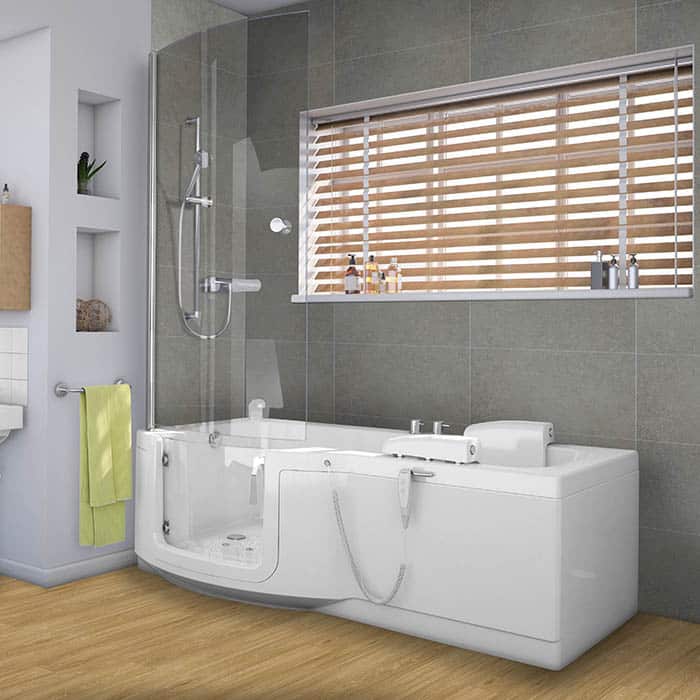Bathroom Sizes Guide UK: How to get the most out of your bathroom size

When it comes to bathrooms, size matters. Why? Because the square footage of your bathroom depends on the designs you choose. Squeezing a large, lavish tub into the downstairs toilet isn’t feasible. But it’s not just about design. The area can also determine which bathroom aids are best. For instance, you may have the space for a bath but find it impossible to climb in and out.
The average bathroom size in the UK is 2 metres x 2 metres, which is about the size of a family bathroom. However, UK bathroom sizes vary. That’s why we’re covering the best ways to design your bathroom and how to adapt each one for mobility issues.
Get a FREE Brochure
Fill out the form in seconds and discover our full range of assisted bathing showers and baths.

Best designs for small bathrooms
Small bathrooms have a toilet, sink, bath-shower combo and towel rack. They’re common in terraced houses and apartments. Therefore, it is vital to utilise the space without making it look cluttered and comprising functionality.
Create a cohesive space in a small bathroom by choosing facilities in the same style and colours. Classic white works well, providing a clean and modern aesthetic.
- Best designs for cloakroom bathrooms
- Best designs for ensuite bathrooms
- Best designs for master bathrooms
- Best designs for family bathrooms
- Make the most of your bathroom space
How to best adapt a small bathroom for mobility issues
You don’t need a large bathroom to accommodate your mobility needs. As long as you select the correct aids, there’s no reason you can’t have a practical and stylish space. Here are a few excellent ways to adapt a small bathroom to suit mobility challenges:
- Compact bathtubs - Our ingenious compact bathtubs fit neatly into small spaces without obstructing the room. They’re perfect if you love a bath but only have a corner area. These therapeutic baths are designed with a walk-in door. So, there’s no need to lift your feet or use bath steps for a relaxing soak.
- Sleek toilet - Don’t overwhelm the room with a large toilet. Instead, opt for an elegant and minimalist style. This will provide more space for you to move around.
- Large taps - No matter what your bathroom size, ensuring you have large, easy-to-use taps is crucial. Install them on the bath and sink to turn the water on pain-free.
Best designs for cloakroom bathrooms
Downstairs toilets or cloakroom bathrooms are extremely handy. They have a toilet and sink but no bath or shower. These bathrooms normally reside on the ground floor, making them instantly accessible. Therefore, you should put some thought into their design because you may use them more than any other bathroom.
How to best adapt cloakroom bathrooms for mobility issues
You don’t want to squeeze around the sink to reach the toilet, as this can be challenging with mobility issues. So, get the most out of your downstairs bathroom by selecting slender designs that maximise the space.
- Choose a slimline toilet - Ditch the clunky toilet and opt for something that fits neatly into the area. A toilet with a button or automatic flush is better than a handle, as they don’t stick out. They’re also easier to use if you have stiff hand joints.
- Install a lift tap for your sink - Look after your mobility issues with a tap that turns on by lifting the handle. You can switch it from side to side to change the water temperature. The style is easier on the joints, and you can avoid straining your wrists trying to turn a stubborn tap.
Best designs for ensuite bathrooms
Ensuite bathrooms usually consist of a shower and toilet. They’re convenient if you regularly get up at night. However, the space quickly disappears if you don’t install facilities wisely. The best option is to open up the floor space to make the room appear bigger. This also allows you to move around without limitation.
How to best adapt an ensuite bathroom for mobility issues
- Choose a curved corner shower - A stylish corner shower slots nicely into an ensuite bathroom without overbearing the space. Our Invigorate Walk-in Shower doesn’t require any steps to get into and has a comfortable seat to rest while you refresh.
- Change your ensuite into a wet room - En Suites are excellent places to turn into small wet rooms. Wet rooms are watertight, tiled spaces with a shower level to the floor and a drain for water flow. There is no need to struggle with shower cubicle doors or slippery tubs.
Best designs for master bathrooms
If you’re lucky enough to own a master bathroom, your options are almost limitless. These bathrooms are usually large, making them the perfect space to relax and unwind. Most master bathrooms contain a separate tub and shower. They’re also ideal for extra bathroom storage. For example, a cupboard full of fluffy white towels or an area to store your bathroom essentials.
How to best adapt a master bathroom for mobility issues
Although master bathrooms are a luxury, the spaciousness can be problematic if you have mobility issues. Everything can be far apart, making it hard to hold onto objects to reduce the likelihood of slipping. So, check out our top tips for adapting a master bathroom:
- Turn into a wet room - The standard wet room size UK is 1.2 metres wide and 1.8 metres long, but they can be bigger. Master bathrooms make deluxe wet rooms and help you avoid the pain or difficulty of stepping into a raised shower. They’re excellent for wheelchair users, as you don’t have to open a shower door but can go straight inside.
- Add a full-length walk-in bath - The average length of a bath UK is 1.7 metres, which you can install into a master bathroom. Our stylish full-length walk-in baths have deep doors, armrests, grab bars and a slip-resistance base for a peaceful soak.
- Install grab rails - A large bathroom can feel daunting if you need help with your balance. Putting grab rails along the walls will help you navigate the room with ease and enjoy your privacy and independence.
- Use slip-proof mats - Slip-proof mats are a simple way to make manoeuvring around the bathroom comfortable. Place them in showers and baths or along the floor, particularly if you have a wet room.
Best designs for family bathrooms
Family bathrooms usually consist of a toilet, sink, shower and bath. Depending on the size, the shower and bath may be separate or combined. These medium-sized bathrooms can be cosy, modern, chic or rustic. The style is entirely up to you. But what is essential is that it’s a safe space for everyone to use.
How to best adapt a small bathroom for mobility issues
The family bathroom gets a lot of use and needs to be functional for everybody, including someone with mobility issues.
- Choose a walk-in shower - No matter your age or mobility, walk-in showers are great for everyone. A standard shower size UK is 0.8 metres x 0.8 metres, making them simple to install for maximum comfort.
- Add a shower tray - Shower trays slope towards the in-shower plug hole for better drainage. They are a fantastic option to channel water away and minimise the risk of slipping. Standard shower tray sizes UK vary, typically from 0.7 metres x 0.7 metres upwards.
Make the most of your bathroom space
It doesn’t matter what size your bathroom is - you can optimise the space and design a room that suits your mobility. Don’t compromise on comfort or style, and browse our range of wet rooms, walk-in showers, and walk-in baths. Relax in peace with Premier Care.

